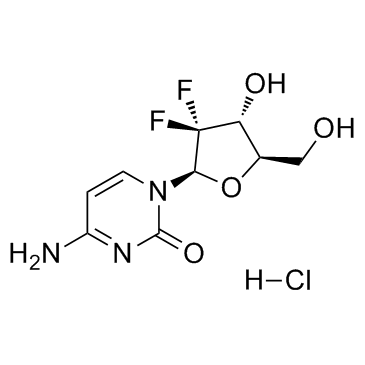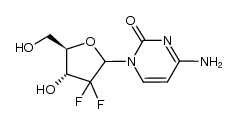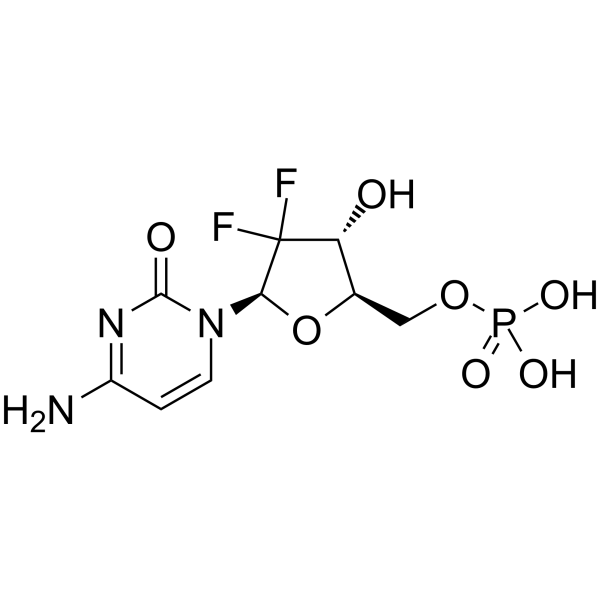95058-81-4
| 中文名 | 盐酸吉西他滨 |
|---|---|
| 英文名 | gemcitabine |
| 中文别名 |
双氟脱氧胞苷
吉西他滨碱 吉西他宾 4-氨基-1-(3,3-二氟-4-羟基-5-羟甲基四氢呋喃-2-基)-1H-嘧啶-2-酮 4-氨基-1-[3,3-二氟-4-羟基-5-(羟甲基)氧杂环戊-2-基]嘧啶-2-酮 吉西他滨 |
| 英文别名 |
4-AMINO-1-[(2R,4R,5R)-3,3-DIFLUORO-4-HYDROXY-5-(HYDROXYMETHYL)TETRAHYDROFURAN-2-YL]PYRIMIDIN-2-ONE
Gemcitabine GEMCITABINE, FREE BASE 2'-DESOXY-2',2'-DIFLUORCYTIDINE CYTIDINE, 2'-DEOXY-2',2'-DIFLUORO 3-DEOXY-2,2-DIFLUORO-D-RIBOFURANOSE-3,5-DIBENZOATE,0.97 4-amino-1-[3,3-difluoro-4-hydroxy-5- (hydroxymethyl) tetrahydrofuran-2-yl]- 1H-pyrimidin- 2-one GEMCITABINE (AS HCL) MFCD00869720 GEMCITABINE HCL 3-DEOXY-2,2-DIFLUORO-D-RIBOFURANOSE-3,5-DIBENZOATE 1-(2-deoxy-2,2-difluoro-β-D-erythropentofuranosyl)cytosine GEMCITABINE API 2'-DEOXY-2',2'-DIFLUOROCYTIDINE EINECS 619-100-6 |
| 描述 | Gemcitabine (NSC 613327;LY188011) 是一种 DNA合成 抑制剂,抑制 BxPC-3,Mia Paca-2,PANC-1,PL-45 和 AsPC-1细胞生长的 IC50 分别为 37.6, 42.9, 92.7, 89.3 和 131.4 nM。 |
|---|---|
| 相关类别 | |
| 靶点 |
DNA synthesis[1] |
| 体外研究 | MTS测定证明,15nM的吉西他滨,50μM的吲哚-3-甲醇(I3C)和该组合不影响hTERT-HPNE细胞活力。然而,用15nM的吉西他滨,50μM的I3C和该组合治疗分别导致BxPC-3细胞31%,19%和72%的细胞死亡[1]。 |
| 体内研究 | 治疗LSL-KrasG12D/+; LSL-Trp53R172H;与安慰剂组相比,使用吉西他滨(50 mg/kg,ip)或组合DMAPT /吉西他滨的Pdx-1-Cre小鼠显着增加中位生存时间超过30天(254.5 [P = 0.015]或255天[ P = 0.018]分别为217.5天)[2]。吉西他滨可通过大鼠气管内喷雾给药,无明显毒性,最大耐受剂量为4mg/kg,每周一次,持续9周。在剂量为2,4和6 mg/kg时,吉西他滨的毒性低于口服给药[3]。 |
| 细胞实验 | 将细胞(人胰腺细胞系,Mia PaCa-2,BxPC-3,AsPC-1,PANC-1,PL-45和正常胰腺导管上皮细胞,hTERT-HPNE细胞)接种到96孔板中(3000细胞/孔)一式三份。孵育过夜后,更换培养基并用I3C和/或NBMPR处理细胞24小时。再次更换培养基,并在存在或不存在相同浓度的I3C和/或NBMPR的情况下,在含有不同浓度的吉西他滨的培养基中培养细胞48小时。然后按照制造商的说明对细胞进行CellTiter 96 AQueous One Solution Cell Proliferation Assay(MTS)。在加入20μLMTS试剂/孔后2小时测量490nm处的吸光度[1]。 |
| 动物实验 | 小鼠[2]在1个月大时,LSL-KrasG12D / +; LSL-Trp53R172H;将Pdx-1-Cre小鼠随机分入治疗组(安慰剂,DMAPT,吉西他滨,DMAPT /吉西他滨)。安慰剂(载体=羟丙基甲基纤维素,0.2%吐温80 [HPMT])和DMAPT(HPMT中40mg / kg体重)通过每天一次口服洗胃施用。每周两次通过腹膜内注射施用吉西他滨(PBS中50mg / kg体重)。每周监测小鼠体重。继续治疗直至小鼠出现嗜睡,腹胀或体重减轻的迹象,此时将其处死。通过检测单个LoxP位点的存在,在小鼠胰腺中确认成功的切除 - 重组事件。大鼠[3]该研究在80只雌性Wistar大鼠中进行,初始重量约为250g。通过耳标识别动物并如下分组。将40只大鼠分成5组,每组8只:4组通过气管内喷雾分别以2,4,6和8mg / kg的剂量肺组织给予吉西他滨(LD2,LD4,LD6,LD8组)和一组接受0.9%盐水载体溶液(组LDv)的喷雾给药。将剩余的40只大鼠分成5组,每组8只:4组分别通过管饲法分别以2,4,6和8mg / kg的剂量口服递送吉西他滨(OD2,OD4,OD6,OD8组),组通过管饲法接受相同体积的0.9%盐水(组ODv)。该协议包括以1周为间隔的九个会话。在两个疗程之间,将动物保持在标准实验室条件下,并在每个笼子中由四只动物的一组饲养,其中有垫料并且可以自由获得颗粒食物和自来水。将笼子放置在与抽吸系统连接的封闭腔室中。 |
| 参考文献 |
| 密度 | 1.8±0.1 g/cm3 |
|---|---|
| 沸点 | 468.0±55.0 °C at 760 mmHg |
| 熔点 | 168.64°C |
| 分子式 | C9H11F2N3O4 |
| 分子量 | 263.198 |
| 闪点 | 236.8±31.5 °C |
| 精确质量 | 263.071747 |
| PSA | 110.60000 |
| LogP | -1.24 |
| 外观性状 | 固体;White to Light yellow powder to crystal |
| 蒸汽压 | 0.0±2.6 mmHg at 25°C |
| 折射率 | 1.652 |
| 储存条件 | <0°C;避免加热 |
| 水溶解性 | 水溶性:实际上不溶 |
| 计算化学 | 1.疏水参数计算参考值(XlogP):无 2.氢键供体数量:3 3.氢键受体数量:6 4.可旋转化学键数量:2 5.互变异构体数量:3 6.拓扑分子极性表面积:108 7.重原子数量:18 8.表面电荷:0 9.复杂度:426 10.同位素原子数量:0 11.确定原子立构中心数量:3 12.不确定原子立构中心数量:0 13.确定化学键立构中心数量:0 14.不确定化学键立构中心数量:0 15.共价键单元数量:1 |
|
Material Safety Data Sheet
Section1. Identification of the substance Product Name: Gemcitabine Synonyms: Section2. Hazards identification Harmful by inhalation, in contact with skin, and if swallowed. Section3. Composition/information on ingredients. Ingredient name:Gemcitabine CAS number:95058-81-4 Section4. First aid measures Skin contact:Immediately wash skin with copious amounts of water for at least 15 minutes while removing contaminated clothing and shoes. If irritation persists, seek medical attention. Eye contact:Immediately wash skin with copious amounts of water for at least 15 minutes. Assure adequate flushing of the eyes by separating the eyelids with fingers. If irritation persists, seek medical attention. Inhalation:Remove to fresh air. In severe cases or if symptoms persist, seek medical attention. Ingestion:Wash out mouth with copious amounts of water for at least 15 minutes. Seek medical attention. Section5. Fire fighting measures In the event of a fire involving this material, alone or in combination with other materials, use dry powder or carbon dioxide extinguishers. Protective clothing and self-contained breathing apparatus should be worn. Section6. Accidental release measures Personal precautions: Wear suitable personal protective equipment which performs satisfactorily and meets local/state/national standards. Respiratory precaution:Wear approved mask/respirator Hand precaution:Wear suitable gloves/gauntlets Skin protection:Wear suitable protective clothing Eye protection:Wear suitable eye protection Methods for cleaning up: Mix with sand or similar inert absorbent material, sweep up and keep in a tightly closed container for disposal. See section 12. Environmental precautions: Do not allow material to enter drains or water courses. Section7. Handling and storage Handling:This product should be handled only by, or under the close supervision of, those properly qualified in the handling and use of potentially hazardous chemicals, who should take into account the fire, health and chemical hazard data given on this sheet. Store in closed vessels, under −20◦C. Storage: Section8. Exposure Controls / Personal protection Engineering Controls: Use only in a chemical fume hood. Personal protective equipment: Wear laboratory clothing, chemical-resistant gloves and safety goggles. General hydiene measures: Wash thoroughly after handling. Wash contaminated clothing before reuse. Section9. Physical and chemical properties Appearance:Not specified Boiling point:No data No data Melting point: Flash point:No data Density:No data Molecular formula:C9H11F2N3O4 Molecular weight:263.2 Section10. Stability and reactivity Conditions to avoid: Heat, flames and sparks. Materials to avoid: Oxidizing agents. Possible hazardous combustion products: Carbon monoxide, nitrogen oxides, hydrogen fluoride. Section11. Toxicological information No data. Section12. Ecological information No data. Section13. Disposal consideration Arrange disposal as special waste, by licensed disposal company, in consultation with local waste disposal authority, in accordance with national and regional regulations. Section14. Transportation information Non-harzardous for air and ground transportation. Section15. Regulatory information No chemicals in this material are subject to the reporting requirements of SARA Title III, Section 302, or have known CAS numbers that exceed the threshold reporting levels established by SARA Title III, Section 313. SECTION 16 - ADDITIONAL INFORMATION N/A |
| 危害码 (欧洲) | Xn,Xi |
|---|---|
| 风险声明 (欧洲) | 21-36/38-46-62-63 |
| 安全声明 (欧洲) | 25-26-36/37-53 |









